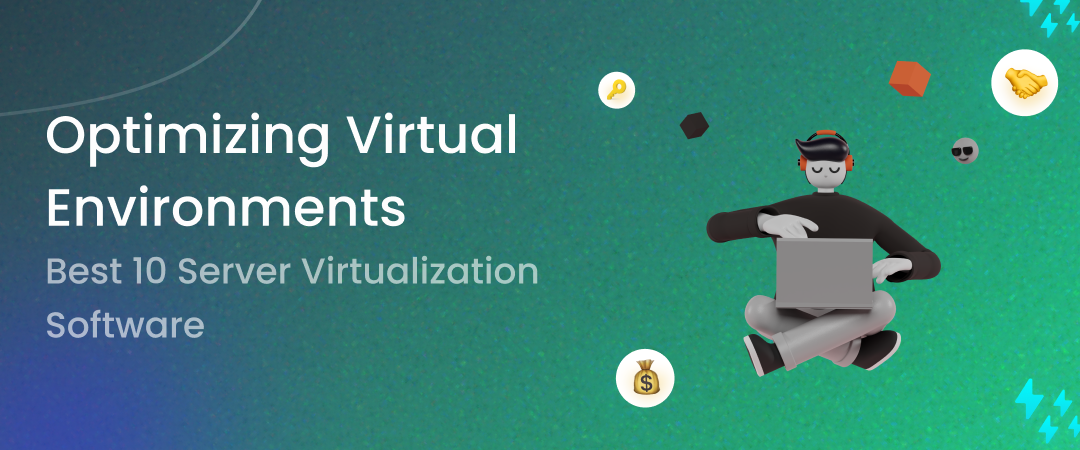

Sign Up
What is best time for the call?
Oops! Something went wrong while submitting the form.

In today's fast-evolving IT landscape, server virtualization has become a fundamental strategy for organizations looking to optimize resource utilization, reduce hardware costs, and enhance scalability. CIOs, CTOs, IT managers, virtualization architects, and infrastructure teams rely on virtualization to improve server efficiency and disaster recovery capabilities.
However, implementing virtualization comes with challenges, such as performance bottlenecks, licensing costs, and security risks. This guide explores the key features to look for in server virtualization software and provides an in-depth review of the top 10 solutions in 2025.
When evaluating server virtualization software, consider the following essential features:
.png)
Overview: Leading enterprise-grade virtualization platform for data centers and hybrid cloud environments.
Key Features: vMotion, DRS, NSX for SDN integration and hyper-converged infrastructure (HCI) support.
Pros & Cons:
Pricing & Licensing: Subscription-based, per-CPU licensing.
User Ratings: Gartner: 4.5/5(1552 reviews) | G2: 4.6/5(597 reviews)
Screenshot:

Overview: Best suited for Windows-based environments and hybrid cloud solutions.
Key Features: Live migration, virtual switch security, and seamless integration with Microsoft Azure.
Pros & Cons:
Pricing & Licensing: Included in Windows Server licenses.
User Ratings: Gartner: 4.3/5(605 reviews) | G2: 4.4/5(17 reviews)
Screenshot:

Overview: Optimized for virtual desktop infrastructure (VDI) and cloud workloads.
Key Features: GPU virtualization, workload balancing, automated live migration.
Pros & Cons:
Pricing & Licensing: Free and paid enterprise versions.
User Ratings: Gartner: 4.3/5(107 reviews) | G2: 4.1/5(48 reviews)
Screenshot:

Overview: Open-source hypervisor is best for Linux environments.
Key Features: Low overhead, direct kernel integration, enterprise support via Red Hat.
Pros & Cons:
Pricing & Licensing: Open-source enterprise support is available via Red Hat.
User Ratings: Gartner: 4.5/5(68 reviews)
Screenshot:

Overview: Enterprise-class virtualization solution optimized for Oracle workloads.
Key Features: Live migration, storage cloning, and integration with Oracle Cloud.
Pros & Cons:
Pricing & Licensing: Free, with optional enterprise support.
User Ratings: Gartner: 4.3/5(54 reviews) | G2: 4.3/5(72 reviews)
Screenshot:

.png)
Overview: Open-source virtualization and container platform.
Key Features: KVM-based hypervisor, LXC container support, built-in clustering.
Pros & Cons:
Pricing & Licensing: Free, with paid enterprise support.
User Ratings: G2: 4.6/5(30 reviews)
Screenshot:

Overview: Hyper-converged infrastructure (HCI) solution with integrated virtualization.
Key Features: AI-driven workload balancing, storage optimization, hybrid cloud compatibility.
Pros & Cons:
Pricing & Licensing: Subscription-based.
User Ratings: Gartner: 4.5/5(29 reviews) | G2: 4.6/5(270 reviews)
Screenshot:

Overview: Open-source enterprise virtualization based on KVM.
Key Features: Scalable architecture, strong security features, automation tools.
Pros & Cons:
Pricing & Licensing: Subscription-based.
User Ratings: Gartner: 4.3/5(100 reviews) | G2: 4.1/5(14 reviews)
Screenshot:

Overview: Cloud-native virtualization platform.
Key Features: Pay-as-you-go pricing, auto-scaling, and integration with AWS services.
Pros & Cons:
Pricing & Licensing: Pay-per-use.
User Ratings: Gartner: 4.6/5(147 reviews) | G2: 4.6/5(1,293 reviews)
Screenshot:

Overview: Google Cloud's scalable virtual machine service.
Key Features: Custom machine types, preemptible VMs, deep AI integration. \
Pros & Cons:
Pricing & Licensing: Pay-per-use.
User Ratings: Gartner: 4.7/5(1372 reviews) | G2: 4.5/5(891 reviews)
Screenshot:

What are the key benefits of server virtualization?
Server virtualization can benefit in cost reduction, improved disaster recovery, and efficient resource utilization.
How does hypervisor technology impact the virtualization performance?
Type-1 hypervisors (bare-metal) offer better performance compared to Type-2 hypervisors.
What are the best free vs. paid virtualization software options?
Free: KVM, Xen, VirtualBox | Paid: VMware vSphere, Microsoft Hyper-V.
How do AI-driven tools improve virtual environment efficiency?
AI automates workload balancing, predictive scaling, and self-healing infrastructure.
Virtualization is essential for IT infrastructure optimization, reducing hardware dependency, and improving performance. This guide's top 10 server virtualization solutions cater to various business needs.
However, selecting the right software is only the beginning. Effective cost management, security, and AI-driven automation are crucial for long-term success.
How CloudNuro Helps with Virtualization Cost & Performance Optimization?
CloudNuro.ai provides:
🚀 Book a demo with CloudNuro.ai today and optimize your virtualization strategy!
.png)
Request a no cost, no obligation free assessment —just 15 minutes to savings!
Get StartedIn today's fast-evolving IT landscape, server virtualization has become a fundamental strategy for organizations looking to optimize resource utilization, reduce hardware costs, and enhance scalability. CIOs, CTOs, IT managers, virtualization architects, and infrastructure teams rely on virtualization to improve server efficiency and disaster recovery capabilities.
However, implementing virtualization comes with challenges, such as performance bottlenecks, licensing costs, and security risks. This guide explores the key features to look for in server virtualization software and provides an in-depth review of the top 10 solutions in 2025.
When evaluating server virtualization software, consider the following essential features:
.png)
Overview: Leading enterprise-grade virtualization platform for data centers and hybrid cloud environments.
Key Features: vMotion, DRS, NSX for SDN integration and hyper-converged infrastructure (HCI) support.
Pros & Cons:
Pricing & Licensing: Subscription-based, per-CPU licensing.
User Ratings: Gartner: 4.5/5(1552 reviews) | G2: 4.6/5(597 reviews)
Screenshot:

Overview: Best suited for Windows-based environments and hybrid cloud solutions.
Key Features: Live migration, virtual switch security, and seamless integration with Microsoft Azure.
Pros & Cons:
Pricing & Licensing: Included in Windows Server licenses.
User Ratings: Gartner: 4.3/5(605 reviews) | G2: 4.4/5(17 reviews)
Screenshot:

Overview: Optimized for virtual desktop infrastructure (VDI) and cloud workloads.
Key Features: GPU virtualization, workload balancing, automated live migration.
Pros & Cons:
Pricing & Licensing: Free and paid enterprise versions.
User Ratings: Gartner: 4.3/5(107 reviews) | G2: 4.1/5(48 reviews)
Screenshot:

Overview: Open-source hypervisor is best for Linux environments.
Key Features: Low overhead, direct kernel integration, enterprise support via Red Hat.
Pros & Cons:
Pricing & Licensing: Open-source enterprise support is available via Red Hat.
User Ratings: Gartner: 4.5/5(68 reviews)
Screenshot:

Overview: Enterprise-class virtualization solution optimized for Oracle workloads.
Key Features: Live migration, storage cloning, and integration with Oracle Cloud.
Pros & Cons:
Pricing & Licensing: Free, with optional enterprise support.
User Ratings: Gartner: 4.3/5(54 reviews) | G2: 4.3/5(72 reviews)
Screenshot:

.png)
Overview: Open-source virtualization and container platform.
Key Features: KVM-based hypervisor, LXC container support, built-in clustering.
Pros & Cons:
Pricing & Licensing: Free, with paid enterprise support.
User Ratings: G2: 4.6/5(30 reviews)
Screenshot:

Overview: Hyper-converged infrastructure (HCI) solution with integrated virtualization.
Key Features: AI-driven workload balancing, storage optimization, hybrid cloud compatibility.
Pros & Cons:
Pricing & Licensing: Subscription-based.
User Ratings: Gartner: 4.5/5(29 reviews) | G2: 4.6/5(270 reviews)
Screenshot:

Overview: Open-source enterprise virtualization based on KVM.
Key Features: Scalable architecture, strong security features, automation tools.
Pros & Cons:
Pricing & Licensing: Subscription-based.
User Ratings: Gartner: 4.3/5(100 reviews) | G2: 4.1/5(14 reviews)
Screenshot:

Overview: Cloud-native virtualization platform.
Key Features: Pay-as-you-go pricing, auto-scaling, and integration with AWS services.
Pros & Cons:
Pricing & Licensing: Pay-per-use.
User Ratings: Gartner: 4.6/5(147 reviews) | G2: 4.6/5(1,293 reviews)
Screenshot:

Overview: Google Cloud's scalable virtual machine service.
Key Features: Custom machine types, preemptible VMs, deep AI integration. \
Pros & Cons:
Pricing & Licensing: Pay-per-use.
User Ratings: Gartner: 4.7/5(1372 reviews) | G2: 4.5/5(891 reviews)
Screenshot:

What are the key benefits of server virtualization?
Server virtualization can benefit in cost reduction, improved disaster recovery, and efficient resource utilization.
How does hypervisor technology impact the virtualization performance?
Type-1 hypervisors (bare-metal) offer better performance compared to Type-2 hypervisors.
What are the best free vs. paid virtualization software options?
Free: KVM, Xen, VirtualBox | Paid: VMware vSphere, Microsoft Hyper-V.
How do AI-driven tools improve virtual environment efficiency?
AI automates workload balancing, predictive scaling, and self-healing infrastructure.
Virtualization is essential for IT infrastructure optimization, reducing hardware dependency, and improving performance. This guide's top 10 server virtualization solutions cater to various business needs.
However, selecting the right software is only the beginning. Effective cost management, security, and AI-driven automation are crucial for long-term success.
How CloudNuro Helps with Virtualization Cost & Performance Optimization?
CloudNuro.ai provides:
🚀 Book a demo with CloudNuro.ai today and optimize your virtualization strategy!
.png)
Request a no cost, no obligation free assessment - just 15 minutes to savings!
Get StartedWe're offering complimentary ServiceNow license assessments to only 25 enterprises this quarter who want to unlock immediate savings without disrupting operations.
Get Free AssessmentGet Started

Recognized Leader in SaaS Management Platforms by Info-Tech SoftwareReviews
